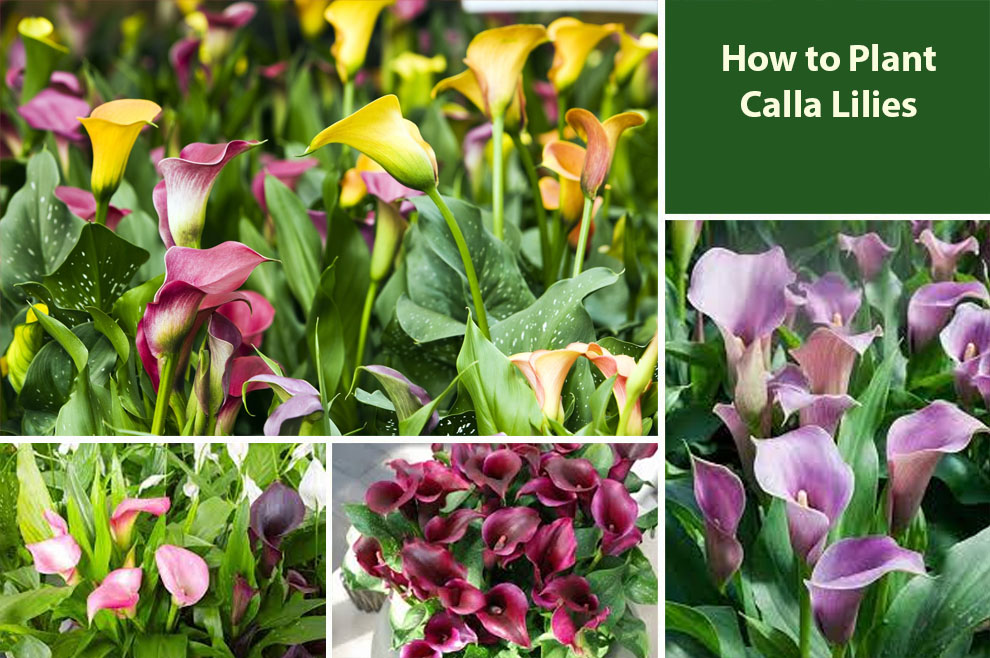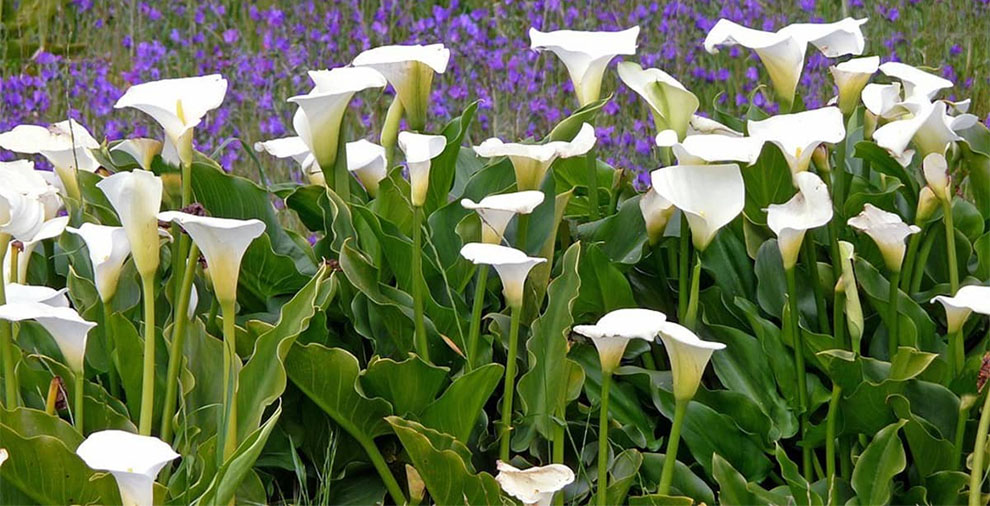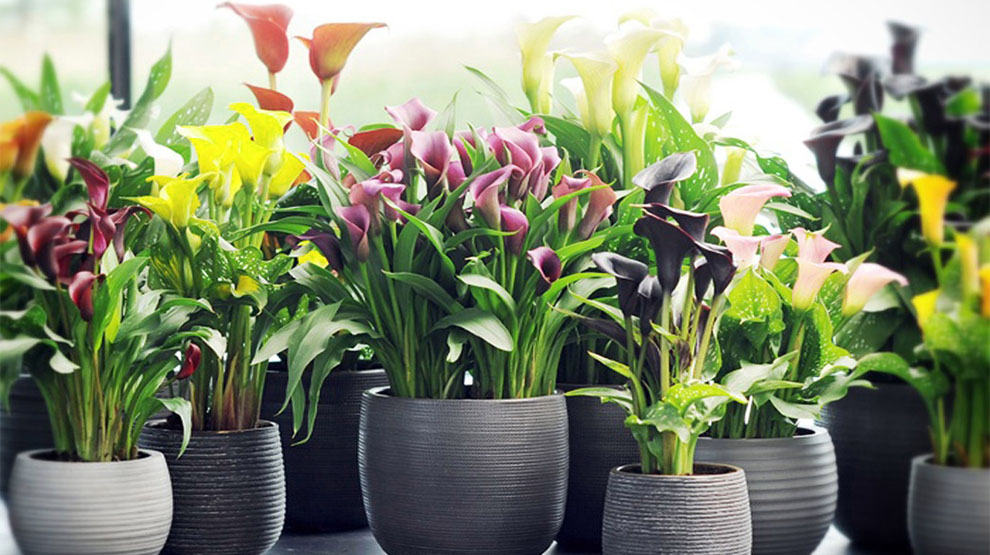How To Grow Calla Lilies (Planting Guide & Care)
Calla lilies grow well via bulb plantation as compared to seeds. Plant the bulbs about four inches deep in well-drained soil and indirect bright sun.

Scientifically called the Zantedeschia spp, the Calla Lilies are vibrant and elegant flowering plants. These are hugely popular in floral arrangements and gardens.
Famous for their glossy green leaves and trumpet-shaped flowers, these plants are unique and can never miss to get your attention. For those of you who don’t know how to grow Calla Lilies, get your supplies ready as we tell you how to add these beauties to your garden.
To begin with, pick a well-drained site with full sunlight or partial shade for your calla lily bulbs. The soil must be rich slightly acidic and rich in organic matter. Plant the tubers or rhizomes in the soil at a depth of two to four inches, with the pointed end facing upwards.
Space calla lilies approximately 12 to 18 inches apart. Water them well to keep the soil consistently moist but not waterlogged. Mulching around the plant’s base can help suppress weeds and retain moisture.
Regular feeding and watering during the growing season can help promote abundant blooms and healthy growth. You can also grow the Calla Lilies in the containers, which allows for easier control of mobility and specialized soil conditions.
Continue reading as we discuss this process as well as other ways to grow calla lilies in detail.
A) How To Plant Calla Lily Bulbs?
Follow the steps listed below before planting rhizomes or Calla Lily Bulbs:
1. Select the right time: Plant Calla Lily bulbs in spring once the frost danger ceases or in the late summer for fall blooming varieties.
2. Select the correct location: Choose a spot in your yard or garden with full sunlight to partial shade. Ensure the soil is slightly acidic, fertile, and well-drained.
3. Prep the soil: Remove the debris or weeds from the planting area. Loosen the soil using a tiller or a garden fork to better drainage and let the bulbs establish well.
4. Digging and spacing: Dig a hole about four to six inches deep. Ideally, space the Calla Lily bulbs 12 to 18 inches apart, with the pointed ends facing upwards. When planting in rows, keep the space about 18 to 24 inches in between the rows.
5. Planting the bulbs: Insert the bulbs into the holes and cover them with soil, gently firming them around the bulbs. Ensure the top of the bulbs is approximately 1-2 inches underneath the soil surface.
6. Care and watering: Water the planted bulbs well to settle the soil and foster root development. Maintain the moist soil across the growing season, but do not overwater, as it may result in root rot.
7. Mulching: Apply a thick organic mulch layer around the plants to suppress weeds, conserve moisture, and regulate soil temperature.
By employing these steps, you can successfully plant Calla Lily bulbs and enjoy their beautiful blooms in the garden.
B) How To Grow Calla Lilies Through Seeds?
While people usually grow Calla Lilies from bulbs, you can also grow them from seeds. Here is a step-by-step guide for growing them from seeds:
1. Sowing the seeds: Commence by filling the seed pots or trays with a well-draining potting mix. Moisten the soil lightly before you sow the seeds.
2. Seed depth: Sow the Calla Lily seeds shallowly, as they need light for germination. Gently press the seeds onto the soil surface. But do not cover them with too much soil.
3. Germination: Place the seed pots or tray in a warm location with indirect light. Keep the soil consistently moist, not waterlogged. Germination will occur in 14-28 days.
4. Transplanting: After the seedlings become robust and develop a few leaves, you can transplant them into the garden bed or individual pots. Ensure the soil is rich with organic matter and is well-drained.
5. Care: Provide the young plants with ample light. The plants need full sun to partial shade. Water them regularly to keep the soil moist but do not overwater. Fertilize using a balanced plant food once a month during the growing season.
6. Blooming: Typically, the Calla Lilies grown from seeds take about two years to mature and yield flowers. Be patient and give them proper care so they manifest as attractive blooms.
Following this Calla Lilies planting guide, you can grow Calla Lilies from seeds. Though it needs attention and patience, it will be a rewarding experience.
When To Plant Calla Lilies?
Depending on the desired blooming period and the climate, you can plant Calla Lilies at different times. Here is the general guideline you can follow:
1. Spring planting: In regions with mild climates, you can plant the Calla Lily bulbs in the spring once the frost danger elapses. It allows them to establish and bloom during early fall and summer.
2. Fall or late summer planting: In regions with cold winters, you can plant Calla Lilies in early fall or late summer, usually around September or August. It lets them establish their roots before winter and bloom the following summer or spring.
Regardless of when you decide on planting the Calla Lilies, please consider the blooming period desired and the recommendations for your climatic zone. Some Calla Lily varieties are summer bloomers, whereas others produce flowers in early fall or late spring.
So check the specific requirements for the specie you grow to ensure optimal blooming times and planting.
Ideally, you can grow Calla Lilies when frost risk ceases, ensuring the soil is warm to give them the best chance to thrive and yield spectacular flowers.
Considerations for Growing Calla Lilies (Ongoing Aftercare)
You have learned how to plant Calla Lilies, but what if you follow the instructions to the T and still do not get the desired results? It is because you do not follow the care instructions related to the Calla Lilies.
Thus, please be well aware of factors like sunlight exposure, water requirements, soil conditions, pest control, and temperature tolerance. These factors have a crucial role in healthy, vibrant cultivation.
A. Is a Calla Lily an indoor or outdoor plant – the best place to grow it?

Calla Lilies are non-fussy. So, you can grow them indoors or outdoors, depending on your preferences and the climate. Outdoors Calla Lilies do good in containers, borders, or garden beds and amplify the beauty of the landscape.
But you can also grow them indoors in containers or pots to decorate and beautify your offices, homes, or any other indoor space. Always decide the best place to grow Calla Lily by considering the climatic conditions, available space, and the desired aesthetic effect.
Also read about other lily houseplant varieties and bring home the one you like the most.
B. Do Calla Lilies grow better in pots or on the ground?
Fortunately, Calla Lilies can grow in the ground or in pots. However, keep in mind a few factors when deciding between the two:
1. Ground planting
Planting the Calla Lilies directly into the ground allows for their natural development and spreading. They have better access to space and soil nutrients for root development, resulting in more robust and larger plants.
Further, ground planting is also better for vaster landscapes or garden beds where you can leave the Calla Lilies undisturbed for longer durations. In the ground, the plants need less frequent watering.
2. Pot Cultivation
Growing Calla Lilies in the pot offers more flexibility, as you can move around the plants to optimize sun exposure and care for the plants as the weather changes.
Potted Calla Lilies are best for gardening enthusiasts with limited space who wish to beautify their indoor areas, balconies, or patios. But these will need more regular feeding and watering as the soil in the pots dries out faster.
C. Best potting soil for Calla Lily
A crucial aspect of the Calla Lilies planting guide is growing them in suitable potting soil. Here are some considerations that you must be aware of:
- Calla Lilies thrive in well-draining soil that lets excess water flush out freely. So, pick a potting mix with coarse sand, vermiculite, and perlite that aid drainage.
- While drainage is vital, Calla Lilies also need consistently moist soil. So, they desire a potting mix that retains moisture sans waterlogging. Go for a blend with organic matter like coconut coir or peat moss, which aids in moisture retention.
- Further, Calla Lilies thrive in a fertile soil mix containing essential nutrients. So, plant them in soil with organic compost or add a well-balanced, slow-release plant food to foster healthy blooming and growth.
- Lastly, Calla Lilies cherish neutral to slightly acidic soils. So, grow them in soil and potting mix with a pH between 6.0 and 7.0 for best growth.
You can shop for commercially available potting mixes suitable for flowering plants or general-purpose blends and amend them to achieve the above-listed characteristics to grow Calla Liles.
D. Calla Lilies watering needs: how often to water calla lily?
The plants have specific watering needs to thrive and yield healthy blooms. These involve:
- Keep the soil moist, not saturated, to avoid overwatering, as it may result in root rot or other conditions.
- Water the Calla Lilies regularly, especially during the growing season. Ideally, you must water enough to keep the soil moist, but let the top soil inch layer slightly dry before you rewater.
- Calla Lilies may suffer from drought stress if you do not feed them the required water. So, during dry and hot periods, you must increase the watering frequently to keep the soil moist. As a general rule, alter the frequency, considering the soil, temperature, and climate in the region.
- After blooming, Calla Lilies enter dormancy. At this time, the plants do not need a lot of water. So, water sparingly, letting the soil dry out slightly between the two consecutive watering schedules. You can resume the regular watering schedule once the new growth shows.
- When growing in pots, water more frequently as the container soil dries out faster than that in the ground.
E. Can a Calla Lily take direct sunlight?

Calla Lilies can withstand and thrive in direct sun, but they also like some shade, especially in the hot climate. Here are some sunlight considerations for Calla Lilies:
- The plants cherish partial shade to full sun. They can endure the direct sun for some hours, but prolonged exposure to intense sun, especially during the hottest hours, can result in leaf burn.
- Morning sunlight is usually preferable, as it is gentle.
- You might want to know how to plant Calla Lily bulbs in areas with hot climates or during heatwaves as well. In a situation like this protect them and provide them afternoon shade by moving them to a spot with dappled shade or using a shade cloth.
- If you plan to expose Calla Lilies to direct sunlight, acclimate them gradually. Start by placing them in a partially shaded area and increase their sunlight exposure over days or weeks.
F. Do Calla Lilies like fertilizers?
Yes, Calla Lilies benefit from regular feeding. It helps support blooming and encourages new growth. Fertilizers provide plants with vital nutrients that may be absent in the soil.
You can also read our recommendations for calla lily fertilizers before buying any.
Fertilizers promote vibrant flowers and healthy foliage. Here are some considerations for feeding the Calla Lilies:
- Use a balanced plant food with similar or equal NPK ratios. It can provide vital nutrients for flowering and maintaining plant health.
- Start feeding when the new growth shows in spring and repeat it once every thirty days across the growing season.
- Do not feed during dormancy.
- Follow the packaging instructions for application rates and dilution. Generally, you must dilute the plant food to half-strength or use it as directed on the package.
- You can opt for well-rotted compost or organic plant foods exquisitely labeled for flowering plants if synthetic options do not appeal to you. These offer slow-release nutrition and better soil quality.
- Do not feed excessively, as it can result in foliage growth at the expense of blooms or trigger fertilizer burn.
We hope we have addressed all your doubts about growing Calla Lilies and caring for them. Now rush and go get started to set up your garden.
